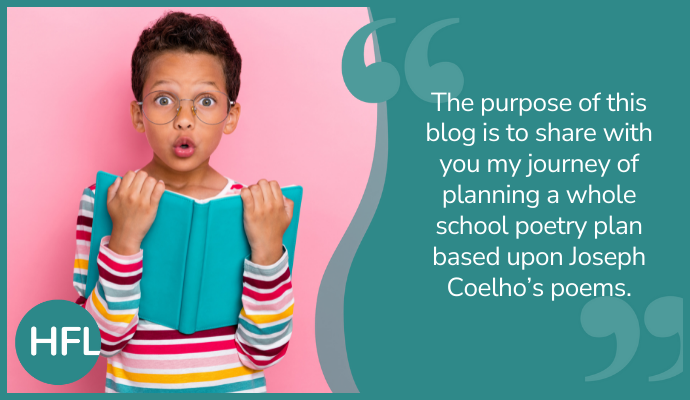
Within this blog you will discover how to receive a free whole school Explore and Engage Poetry Plan!
An exploration of how to set about planning a poetry sequence:
In preparation for our vocabulary conference, I set about writing a whole school Explore and Engage plan in honour of our opening speaker - Children’s Laureate, Joseph Coelho. To say that I felt overwhelmed was an understatement. How could a mere mortal such as myself do this great author and poet of our time justice? Seriously, I had to breathe deeply every now and then and use mindfulness techniques to convince myself that I knew what I was doing. I only share this with you as some of you might feel the same when it comes to planning poetry for your pupils. Currently, colleagues from quite a few of my schools are keen to get poetry back on the menu as it were, back in the limelight and back where it belongs as a priority and not an after-thought within the scheme of teaching sequences.
My thinking as to the purpose of this blog is to share with you my journey of planning a whole school poetry plan based upon Joseph Coelho’s poems and I have aimed to relay some tips to help you to relax and enjoy the process of planning and teaching poetry.
I was fortunate enough to have experienced Joseph performing one of his poems a few years ago and this was where I sought my initial inspiration. This is the link that I used to re-engage with the poet’s voice, style and skill. I could relate to this poem on a few levels when I heard Joseph perform this and it has stayed with me.
In writing the plan for KS1 and KS2 pupils, I chose to use the following two anthologies:
- Poems Aloud by Joseph Coelho, illustrated by Daniel Gray-Barnett
- Overheard in a Tower Block by Joseph Coelho, illustrated by Kate Milner
Advice bite 1
Try and forge a personal engagement or relationship with the poem/s you choose for your pupils. If you love the poem, this joy will permeate through your plan and is likely to impact upon the children. Attempt to seek a clip of the poet reciting or performing their poetry. Always have in mind the joy of learning the poem off by heart and how certain lines, refrains and verses might be performed.
Advice bite 2
If you are using a collection or anthology of poems, take time to read them at your leisure, away from work and just absorb them as a reader, not as a teacher. Recognise why you connect with some poems and think about how you might support your pupils to gain that sense of connection.
Advice bite 3
Once you have selected your poems, read them again as a teacher and appreciate that your pupils may come to them from a different perspective than you did. What might be their difference of opinion/view based upon their feelings or experiences? Is your plan open and broad enough to allow for individual interpretations as this is the beauty of poetry teaching and learning? Do you need to plan for real experiences to enable a ‘taste’ for the poem?
Advice bite 4
I think it is important that primary aged children experience the playfulness of poetry as well as be guided through anything within the poem that might trigger an unexpected reaction from them based upon their lived experience. The best poems can be completely playful and inventive, and some might resonate with a child’s lived experience. Be prepared for this and plan how you will manage the children’s opinions and interpretations.
Advice bite 5
Decide if you are planning for a free form interpretation of the poem or if you are going to provide models from the poem for the children to mimic. The latter might be the case when you are using particular poetic forms such as limericks or haikus. It could be that you choose a refrain for the children to build their own version or use a particular verse as a start point.
Advice bite 6
Brush up on poetic terminology if in doubt! I don’t think that we need to labour at ensuring that the children use terms such as refrain or couplet for example, but it can be good to know them, as an upper KS2 teacher. Revise figurative language terminology such as alliteration, personification, simile and metaphor. If some of you feel that these terms are not suitable for your KS1 pupils, try and think of how you can reinforce the learning without using the terminology. Some KS1 teachers I know have said that they have introduced the concept of metaphor without over emphasis on understanding the term and that the children have been able to use this technique in their poems without realising it!
Advice bite 7
I am going to end with lucky number seven! My final thought is…. please enjoy the poems that you choose to teach your children. Absorb them, feel them, and imagine them being interpreted and performed by you and your class. Feel the rhyme, rhythm, or other emphasis that the poet uses and practice how you would read it aloud and perform it. This might even involve some personal rehearsal of movement, actions and even a little dance routine that helps to bring the poem to life for the children. Think carefully about how you will engage the children with the poem and then onto how you will support their exploration of it. Love poetry and value the wealth of vocabulary that it introduces the children to: engage, explore and enjoy!



